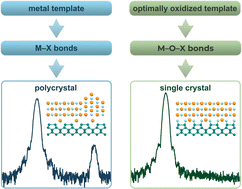Interfacial bond engineering for direct integration of functional oxides with Si and Ge†
Abstract
Integration of oxides with mature technological platforms fuses and enhances the functional properties of the two material systems. However, direct synthesis of crystalline oxides on semiconductors such as Si and Ge is very challenging, especially under energy-saving, low-temperature conditions. It is recognized that the interfacial chemistry holds the key to the integration of oxide/Si and oxide/Ge systems. The standard routes based on surface protection by 2D metal superstructures often fail – only a handful of oxides have been grown epitaxially on Si and Ge with an atomically abrupt interface. Here, an alternative route to oxide synthesis, via optimally oxidized metal superstructures, is established. The result of the chemical engineering at the interface is a radical transformation of the oxide film from a polycrystal to a single crystal. The universality of the proposed synthetic approach is demonstrated by variations of the substrate, Si or Ge, the oxide, EuO or SrO, and the stoichiometry of the metal superstructure. The results provide a key enabling technology to develop oxide electronics on traditional semiconductor platforms.



 Please wait while we load your content...
Please wait while we load your content...